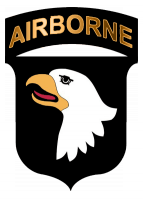 Fort Campbell, KY – On December 12th, 1985, Fort Campbell and the 101st Airborne Division lost 248 Soldiers to one of the worst air disasters in military history.
Fort Campbell, KY – On December 12th, 1985, Fort Campbell and the 101st Airborne Division lost 248 Soldiers to one of the worst air disasters in military history.
This Sunday marks the 25th anniversary of one of the most devastating losses in 101st Airborne Division history.
The Soldiers, along with eight crewmembers, died in an early morning plane crash at Gander, Newfoundland, International Airport, returning from a 6-month peacekeeping mission to the Sinai Peninsula in the Middle East. The Arrow Air DC-8 plane they were aboard crashed upon takeoff.
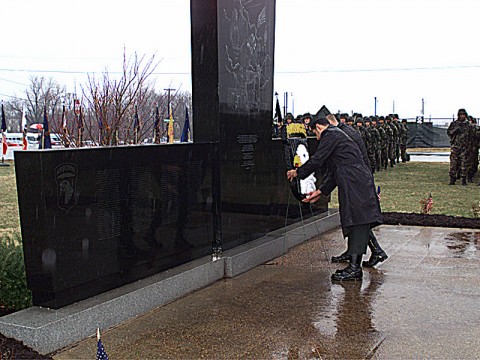
The Soldiers, from several different military units at Fort Campbell, were all attached to 3rd Battalion, 502nd Infantry Regiment, 2nd Brigade, 101st Airborne Division.
Fort Campbell’s annual remembrance and wreath laying ceremony will be Sunday, starting at 1:00pm. All community members, whether personally impacted by the crash or not, are invited to attend the ceremony at Fort Campbell’s Task Force 3-502nd Memorial Tree Park, located between Normandy and Screaming Eagle boulevards.
Retired Maj. Gen. John Herrling, 2nd Brigade commander at the time of the crash, is scheduled to speak, along with the Army’s Chief of Chaplains Maj. Gen. Douglas Carver, a Fort Campbell chaplain in 1985.
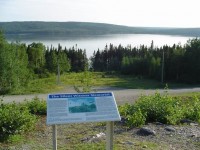
“It’s been 25 years but I haven’t forgotten as I’m sure they surely have not forgotten,” said Herrling about surviving Family members in an interview earlier this year. “Their sons and daughters did a wonderful job, and they really need to be proud of their service.”
Installation Chaplain Roger Heath, 101st Airborne Division DIVARTY chaplain 25 years ago, remembers that December day vividly and will also be attending the ceremony.
“We made our way to the 2nd Brigade gym to be with the Families awaiting their return. Many were gathered in the gym with lots of welcome home signs, flowers, yellow ribbons.”
Heath recalls a chorus of screams and crying when the commander came to the microphone with the official announcement of no survivors.
“It was the first time I felt the cost in human terms what our nation pays for peace in the world,” he explained. “It takes more than beans, bullets and money. It often takes lives to keep our world safe. Taxpayers pay some expenses and bills, Soldiers pay the ultimate price.”
Hopkinsville will also host at memorial service at the city’s Gander Memorial Park, Sunday. The ceremony is from 3:00pm until 4:30pm.
Original Story: 248 Fort Campbell Soldiers killed
Written by Sp4 James Hull
Public Affairs specialist
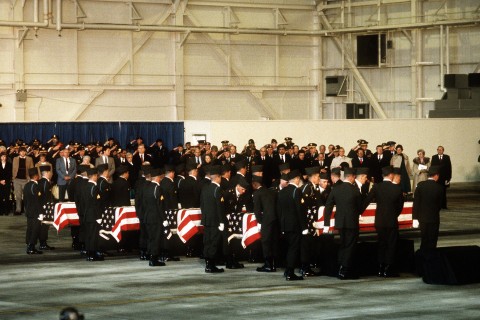
Some 248 101st Airborne Division (Air Assault) and Fort Campbell Soldiers were killed in an early morning plane crash at Gander (Newfoundland) International Airport today, returning from six months of peacekeeping duty on the Sinai Peninsula in the Middle East.
The Soldiers, representing many division and post military units, died when the chartered Arrow Air DC-8 plane they were aboard crashed on takeoff at about 6:45am, Newfoundland time, this morning.
The pilot and crew of eight also died in the crash, bringing the total number of dead to about 256.
Canadian Transport Minister Don Mazankowski said the airplane got no higher than 1,000 feet into the air before crashing.
The crash is the worst ever in Canada and is reported to be the worst air disaster in U.S. military history.
“This is the deepest and most heart-felt tragedy of my time in the Army,” division and post commander Maj. Gen. Burton D. Patrick told about 70 news reporters at a 12:30pm news conference today. “The first priority of this division now is the Families.”
The general said Family members who had gathered at a post gymnasium to greet the home-bound Soldiers had been informed of the tragedy.
Patrick said a Family support center had been set up within hours of the crash and that other Fort Campbell Families were assisting in comforting survivors.
“This division and the entire United States Army is in mourning today. We have suffered a tragic loss. Cohesion and comradeship are like still waters…they run deep.”
“This tragedy will have an everlasting impact, but the fiber of this division is strong,” Patrick said, obviously moved by the tragedy.
“We will take care of the Families, reconstitute our forces and continue with the mission. They wouldn’t want it any other way.”
Patrick said that since about 45 percent of the Soldiers stationed at Fort Campbell were married, he estimated approximately half the Soldiers in the crash could have been married.
As Patrick spoke, a “response team”, headed by Maj. Gen John S. Crosby, was headed to the scene of the crash to “provide all possible assistance.”
Once the Soldiers’ bodies are claimed by the Army, they will be transported to Dover AFB, Delaware, where they will be identified.
Patrick said Families will be notified from Dover and that names of the killed Soldiers will be released to the public as the Families are notified.
The commander said a memorial service will be held “as early as practical next week.”
This was the third of four contingents returning from the Sinai mission. About 970 Soldiers were in the task force. The rotational force had been part of the Multinational Peacekeeping Force and Observers since July.
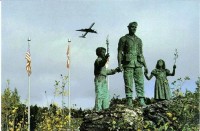
The Multinational Peacekeeping Force and Observers on Egypt’s Sinai Peninsula has troops from the United States, Fiji, Colombia, Australia, New Zealand, the Netherlands, Italy, Uruguay, France and England. They are under command of military officers from Norway.
The MFO was created as a peacekeeping force to police the disengagement of Israeli and Egyptian troops under the two nations’ 1979 peace treaty, the only such treaty between Israel and an Arab country.
The ill-fated DC-8 had flown from Cairo, Egypt to Cologne, West Germany, where it refueled. Gander was the second refueling stop and last leg of the journey to Fort Campbell.
Gander International Airport is located approximately 150 miles northwest of St. John’s, the capital of Newfoundland on Canada’s Atlantic seaboard. It is often used by planes traveling between North America and Europe.
The Soldiers returning from the Sinai were being replaced by the 3rd Battalion, 60th Infantry, 9th Infantry Division from Fort Lewis, Wash., in a rotation which began earlier this month.
Although the exact cause of the crash has not been determined, officials have ruled out sabotage. The accident remains under investigation.
3-502nd bears terrible cost
Written by Sp4 James Hull
Public affairs specialist
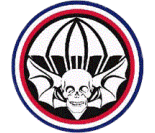 Considering there are scores of agency representatives, technicians and volunteers to comfort and aid the 248 Families affected by last week’s tragic Arrow Air DC-8 crash, there is one group, almost as keenly affected, undergoing the unenviable task of “continuing with the mission.”
Considering there are scores of agency representatives, technicians and volunteers to comfort and aid the 248 Families affected by last week’s tragic Arrow Air DC-8 crash, there is one group, almost as keenly affected, undergoing the unenviable task of “continuing with the mission.”
They are the Soldiers of the 3rd Battalion, 502nd Infantry Regiment. The Soldiers whose comrades perished in the crash. The Soldiers who worked side by side with those who died.
Military bearing means more now to the Soldiers of the 3rd Bn., 502nd Inf. Rgt., than perhaps it does to any other military unit.
“We’re all leaning on each other,” said Chaplain (Capt.) Richard Murdoch.
Murdoch bears an extra grief. Until he was replaced by (Capt.) Troy Carter earlier this year, he was the chaplain for this grieving battalion. The men who died in the DC-8 crash were his men. And sadly enough, Carter was also killed in the crash.
But Murdoch remains strong. “The thing is,” he said, “we look to the chaplain as God’s agent for blessing and comfort.”
In an effort to prevent the Soldiers from focusing on their own grief, Murdoch helped put together a system whereby each of the Families in the Fort Campbell area has been assigned a Soldier from the battalion.
The Soldiers augment the work of the official assistance officers assigned to each Family.
“It’s a safety net,” Murdoch explained, “so that we know someone from this command is contacting our Families every day. Our Soldiers act as a point of contact to the assistance officers.”
Acting battalion commander, Maj. Frank Hudoba, battalion executive officer, has also kept the Soldiers busy by scheduling daily briefings and updates with battalion leaders.
“The biggest thing is to keep busy,” Hudoba said. “To do for the people that suffered a greater loss than we did.”
Hudoba said the unit has the material to print a yearbook containing a special section on the lost Soldiers, and he is soliciting suggestions from his men on the establishment of a “living memorial” for the 248 dead.
When the Families have left this area, they will have cherished photographs, letters and other articles of remembrance to hold on to of their loved ones.
The Soldiers of the 3rd Bn. 502nd Inf. Rgt. will have each other.
Maj. Gen. John Herrling Answers Questions
Do you remember December 12th, 1985? What you were doing? Where you were? And how you felt when you got the news of the crash?
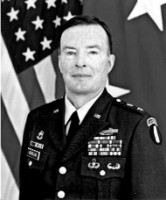
“I remember it like it was yesterday. At the time I was in the kitchen getting ready to go off to the brigade headquarters for PT. It was about 6 in the morning and I got a call from the brigade S3 and he said he had heard the news on TV and they were reporting a crash of a military aircraft in Gander, Newfoundland and he said ‘that’s a strange coincidence, our guys are coming back from the Sinai.’ I walked across my driveway to my next door neighbor who was the chief of staff of the 101st. Col. Bruce Moore and I relayed the conversation with Bruce and he got a hold of the 101st operations center. So I went off to the brigade headquarters and he went to the division headquarters and he called me maybe 15-20 minutes later and he said, ‘I got some bad news for you, that was your plane that went down and right now they’re reporting no survivors,’ and that’s how I found out about it.”
“I had a real feeling of despair but my real concern was for the Families and the friends that would be gathering in a couple of hours to welcome that group back to Fort Campbell. That was the real focus of my attention.”
“I just knew that all of us in the 101st were going to have to do everything that we could for the families and friends of those that had been lost in that plane crash. So we started putting everything together and figuring out how we were going to do that. My big concern was we were having a welcome back ceremony in the 2nd brigade gym, I believe it was scheduled for 9:30 a.m., and I had to figure out what I was going to say to those people when I walked into that gymnasium.”
The rumors were out and the news was reporting the crash so there were families and friends that had already assumed it was the flight that they were waiting on that wouldn’t make it home.
“There were rumors and people had already heard the television reports and there was a lot of concerned folks but I still had to get up and make a formal announcement.”
“In the time I had between confirming that was our group of folks and walking into that gym I had some time to write myself some notes.”
How does a commander deal with such a tremendous loss?
“It was the most difficult period in my Army career I think and that particular morning was probably the most terrible time I had in the 35 years I spent in the military. You just have to sit there and think for a minute on what you can do for the families and all the friends that had gathered there to welcome them home. That’s your first and primary concern, what can we do to help the families.”
In just three hours, he coordinated with the division personnel officer, division adjutant general and the hospital to put together a group of people that could be most beneficial to the families.
“I knew when I walked into that gymnasium and made the formal announcement we were going to have some very troubled people. So we needed medical staff in there to help deal with all that.”
How did the crash affect the rest of your military career?
“Once you go through a tragedy like that you realize that this can happen at other places and other times. I think for the rest of my time on active duty, whenever we were involved in a large exercise and we were moving people around and we were training somewhere, safety was foremost in my mind. We took every course that we could to ensure that what you were doing was as safe as it could possibly be and that you weren’t jeopardizing anybody’s life or limb by neglecting to think of something that needed to be done.”
Do you still relive the day of the crash?
“For the first year I thought of the crash daily and then other years as they passed I would go back less frequently.”
If the victims could hear you now, what would you say to them?
“I would just tell them that they did a terrific job the six months they were in the Sinai. You couldn’t have asked anything more from a group of Soldiers and the mission they had over they. They did it perfectly. Everyone realized that the 3rd battalion and the task force over there had just done one super job and the commander of the multinational force and observers, who commanded that battalion when it was in the Sinai, saw it fit to come to the states for the memorial service, he felt that strongly about it.”
Was that the final rotation of 101st troops in the Sinai? If so, did the mission end or did it get turned over to another peace-keeping force?
He wasn’t sure.
Did any 502nd Soldiers assist with the funeral detail in Dover?
“Major General Burton Patrick, the 101st Airborne Division commander at the time, insisted that the remains of the Soldiers, that once they were identified at Dover Air Force Base be escorted by detail from the 101st and he made that happen. So every Soldier, once they left Dover, they had an escort to take them back to their home town or back to Arlington National Cemetery or wherever the Family wanted them to go.”
Do you have a message you want to get out to the victim’s families?
“It’s been 25 years but I haven’t forgotten as I’m sure they surely have not forgotten. Their sons and daughters did a wonderful job and they really need to be proud of their service. It really is a tragedy and it just points out the fact that they were on a peace keeping mission and keeping the peace is sometimes a very difficult thing to do. Sometimes there’s a price to keeping the peace and in the case of those Soldiers they paid a very dear price and so did their Family and friends for their service in the Sinai.”
In reference to a ceremony dedicating the grove of Canadian Sugar Maple trees at Fort Campbell in September 1987 — Did you meet Janice Johnston, the 16-year-old Canadian girl who sparked the effort to plant the trees? No, not that he can remember. Were you there for the dedication? “I was there and came back because I was stationed in Europe at the time. I was able to come back for that.” What are your thoughts about the memorial trees? “It’s a wonderful way to honor those that died at Gander. It’s a growing thing. It’s a living thing. Those trees will be there for years and years and it will be a constant reminder to not only Family and friends but a constant reminder for Soldiers serving at Fort Campbell the sacrifice that some of the predecessors made back 25 years ago.”
Have you ever visited any of the other memorials and if so what have you thought of them?
“I was at the inauguration of the memorial in Hopkinsville, when it was dedicated and it was very well done.”
“It wasn’t only tough on me but it was tough on my wife and some of the other division wives because they had to deal with a lot of the wives whose husbands had died and so it was very traumatic for them too, but we got a lot of help from the division, across the Army and the surrounding communities.”
“It was just a tragedy that was hard to deal with and I think Department of the Army did a great job. They sent a bunch of psychiatrist and psychologist in to talk to people, particularly those in the battalion that had come in on the first or third flight because inevitably somebody was going to look in the mirror and think ‘why didn’t this happen to me, why did I have a safe flight and those guys didn’t.’ There were some psychological problems that had to be dealt with and the Army did a great job in sending in teams of folks who could sit down and talk to them individually or in groups and try to resolve some of their problems.”
Casualties
The following list of Soldiers killed in the plane crash at Gander, Newfoundland, Canada, appeared in the Kentucky New Era, Hopkinsville, KY, December 16th, 1985, as supplied by the Pentagon on December 15th, 1985.
| Pfc. Mark E. Abrams | 1st Lt. Joey McCarty | |
| Pfc. Herbert D. Alexander | Spc. Christine M. McCleery | |
| Staff Sgt. Steven A. Andreoff | 1SG Robert F. McCook | |
| Spc. Danell Andrews | 2nd Lt. J. Scott McCormick | |
| Spc. Ivan R. Aponte | Spc. Calvin McWhite | |
| Pvt.2 Stuart N. Arrowood | Staff Sgt. Jerry W. Malone | |
| Spc. Roger D. Arvin | Capt. Edward J. Manion | |
| 1st Lt. Luis A. Avillan | Pvt.2 Thomas L. Martin | |
| Spc. Bobby L. Banks | Pvt.2 Donald L. Mathis | |
| Spc. Daniel M. Barber | Sgt. Ronald C. Mayhew | |
| Pfc. Eric J. Bauman | CW2 Dirk A. Miller | |
| Pvt.2 Edward M. Beer | Sgt. Larry G. Miller | |
| Spc. Wyatt D. Benson | Staff Sgt. Richard D. Miller | |
| Pfc. Sammy D. Bittle | Spc. Timothy E. Miller | |
| CSM Hasland O. Black | Sgt. John M. Millett | |
| Pfc. Paul J. Bostwick | Sgt. James A. Mollett | |
| Sgt. John P. Bowen | Staff Sgt. Samuel T. Moore Jr. | |
| CW3 Robert Bowen | Pfc. Lindale Morgan | |
| Spc. John T. Bradley Jr. | Spc. Steven W. Mullins | |
| Spc. Steven J. Bradshaw | Sgt. Michael Murray | |
| Pfc. Darrin P. Brady | Spc. Michael A. Napier | |
| Sgt. Charles F. Brancato | Sgt. 1st Class Joseph A. Nartia | |
| Spc. Tony L. Brasfield | Sgt. 1st Class Donald C. Nelson | |
| Pvt.2 William R. Brilya | Pvt.2 Kenneth J. Nelson | |
| Spc. George A. Britt | Staff Sgt. Steven R. Nelson | |
| Pfc. Johnny L. Brown | Sgt. Richard S. Nichols | |
| Pvt.2 Gregory A. Buchanan | Pfc. Michael T. Nolan | |
| Spc. James D. Burdette | Sgt. Francisco Ocasio Jr. | |
| Pfc. David A. Bury | Pfc. Robert L. Olson | |
| Pvt.2 Trevor Campbell | Pvt. Gregory A. Owens | |
| Pfc. Gregory T. Carter | Spc. Gary W. Padgett | |
| Sgt. Mark E. Carter | Pfc. Theodore L. Pafford | |
| Capt. Troy G. Carter | Sgt. Jeffrey R. Palmisano | |
| Pvt.1 Dennis Cartwright | CW3 Rudy Parris | |
| Pvt. Phillip R. Caudill | Sgt. Thomas F. Parsons | |
| Pfc. Garett R. Chaddock | Pvt.2 Vickie S. Perry | |
| Spc. Stephen R. Colby | Spc. Terry R. Pevey | |
| Pfc. Bobby L. Coleman | Pvt.2 Alvin Phillips | |
| Sgt. Miguel A. Cordero | Sgt. James D. Phillips Jr. | |
| Pfc. Orlando F. Council Jr. | 1st Lt. Barry C. Powell | |
| Pfc. Michael E. Craig | Spc. Raimo K. Puntanen Jr. | |
| Pvt.2 Paul M. Crawford | Spc. Michael R. Rahr | |
| Spc. Francisco Cruz-Salgado | Capt. Terry L. Rains | |
| Pfc. Troy R. Cupples | Pfc. David L. Rawls | |
| Pfc. Walter G. Daniels | Patrick S. Reasbeck | |
| Spc. Thomas Danielson | Pvt. Melvin W. Reed | |
| Sgt. James A. Davis | Staff Sgt. Jessey T. Reynolds | |
| Spc. Jimmy D. Davis | Pfc. Gregory W. Richardson | |
| Staff Sgt. Thomas E. Davis | Pfc. Richard D. Rimiller | |
| Pfc. Herbert R. Deckman | Spc. Bobby E. Roberts | |
| Cpl. Joseph L. Diventura | Staff Sgt. Wilbur G. Roberts Jr. | |
| Spc. Thomas D. Dixon | Sgt. Vergil L. Robertson Jr. | |
| Staff Sgt. James F. Duckworth | Sgt. Thomas E. Robinson Jr. | |
| Sgt. Brian L. Dumpert | Pfc. Ronald C. Russell | |
| Sgt. Brian E. Easley | Spc. Ray A. Ruth | |
| Capt. Michael C. Eastman | Spc. Ricky A. Schmoyer | |
| Capt. Kyle L. Edmonds | Sgt. Peter E. Schremp | |
| Spc. Christopher Englebert | Pfc. Keith M. Schultz | |
| Sgt. James A. Ferguson | Spc. Gary L. Scott | |
| Spc. Mark W. Ferguson | Pfc. Blanchard T. Searcy | |
| Pvt.2 Kevin F. Fink | Staff Sgt. Ronald W. Sears | |
| Spc. David Fitch | Pfc. Frederic C. Seitz | |
| Cpl. Thomas J. Foskey | Staff Sgt. Timothy D. Sellner | |
| Cpl. Paul K. Fuller | Pvt.2 Ernest W. Serna | |
| Sgt. Kevin A. Gantzer | Spc. Michael D. Shipley | |
| Spc. Anthony L. Gayton | Pfc. James E. Shook | |
| Pfc. Scott W. Gerdes | Pfc. Robert D. Shultz | |
| Sgt. Gary L. Givens | Spc. Carl N. Simmons | |
| Sgt. 1st Class David L. Godsey | Spc. George H. Simmons | |
| Spc. Michael J. Gonzales | Sgt. Earl Singleton | |
| Pfc. Roberto Gonzalez | Spc. Matthew S. Sloan | |
| Pvt.2 Joseph W. Goree | Pvt.2 Clinton D. Smith | |
| Spc. Kelly O. Graham | Sgt. 1st Class Rex V. Smith | |
| Spc. Thomas L. Graham | Spc. Scott J. Smith | |
| Staff Sgt. Douglas F. Grala | Pfc. Thomas E. Smith | |
| Spc. Christopher Gray | Pvt. Mark Spearman | |
| Pfc. Richardo Guerra | Spc. James M. Spears | |
| Capt. Brian D. Haller | Spc. Michael S. Stack | |
| Pfc. William W. Hansen III | Pfc. David C. Staten | |
| Pvt.1 Chester D. Hardeman | Pfc. Alexander W. Stearn | |
| CW3 Benny J. Harden | Spc. Dane Stephens | |
| Pfc. Brian D. Harris | 2nd Lt. Kip L. Stevens | |
| 2LT Robert B. Hart | Sgt. Randy S. Stewart | |
| Pvt.1 Mark S. Hassing | CW2 Earl C. Stone | |
| Spc. Reginald Haugsdahl | Pfc. Gary L. Straub | |
| Pvt.1 David W. Heidecker | Spc. Richard Stringer | |
| Sgt. Paul C. Hemingway | Pvt.2 Scott A. Stritch | |
| Pvt.2 Joe W. Highfill | Sgt. Randall K. Thomas | |
| Pfc.Thomas T. Hileman | Spc. Robert F. Thomas | |
| Spc. Donald E. Hobbs | Sgt. Danny C. Thompson | |
| Pfc.Kevin S. Hobbs | Spc. Scott B. Thompson | |
| Staff Sgt. Jerry W. Holliman | Sgt. Christopher G. Thornton | |
| Spc. Robert S. Hoyer | Sgt. Theodore Travis | |
| Spc. Charles W. Hughes | Pvt.2 Thomas N. Tucker | |
| Staff Sgt. Frank J. Hughes | Staff Sgt. Vincent L. Turner | |
| Pfc. Jeffrey D. Hull | Pfc. Steven C. Venneri | |
| Cpl. Herbert G. Ivy | Pfc.Wayne Vinson | |
| Pvt.1 Adrian D. Jackson | Spc. Gregory Walker | |
| Lt. Col. Marvin A. Jeffcoat | Spc. Guy W. Walker | |
| Staff Sgt. Donny K. Jennings | Pfc. Brian E. Wallace | |
| Spc. Todd M. Jennings | Pfc. Mark E. Wallace | |
| Pvt.1 Jerrin A. Johnson | Sgt. 1st Class Abraham Ward | |
| Staff Sgt. Ravon L. Johnson | Sgt. 1st Class Thomas E. West | |
| Sgt. Joseph A. Jones | Pfc. John C. Wester | |
| Pvt.2 David A. Jordan | Spc. Frank C. Wheeler | |
| Spc. Robert S. Kaplin | Staff Sgt. Emery S. White III | |
| Sgt. Ibrahim Karadsheh | Spc. Michael L. Whiteman | |
| Spc. Jeff S. Kee | Staff Sgt. Darnell Wilburn | |
| Sgt. Timothy L. Kidd | Pvt.2 Franklin R. Wilkins | |
| Pfc. Jerry J. King | Spc. Rodger L. Wilson | |
| Capt. Robert M. King | Staff Sgt. James A. Winston | |
| Staff Sgt. Thomas J. Kirby | Spc. James H. Williamson | |
| Pfc. Bruce E. Kiser | Sgt. Richard N. Willingham | |
| 1st Lt. John K. Kosh | Spc. Theodore M. Wisson | |
| Staff Sgt. Mark R. Kubic | 1st Lt. John B. Witmer | |
| Spc. John M. Kuehn | Sgt. Kevin M. Witt | |
| Spc. Randall A. Lane | Sgt. Robert N. Wolford III | |
| Maj. Michael R. Lawrence | Staff Sgt. Lawrence A. Wood | |
| Sgt. Donald G. Lineberry | Sgt. William L. Wooliver | |
| Pfc. William M. Lloyd | Spc. Virginia R. Word | |
| 1st Lt. Paul D. Long | Spc. John R. Wright | |
| Spc. David C. Lundgren | Pfc. Robert Wyn | |
| Pfc. Benjamin R. Lynch | Pfc. Cary T. Yeargan | |
| Sgt. Paul A. McArdle | Spc. Cathleen M. Ziegler |
Cockpit Crew
John Griffin, Captain
John Robert Connelly, First Officer
Mike Fowler, Flight Engineer
Cabin Crew
Maia Matasowski, Flight Service Manager
Jean Sarafin, Flight Attendant
Desiree McKay, Flight Attendant
Ruthie Phillips, Flight Attendant
Stacy Cutlar, Flight Attendant


